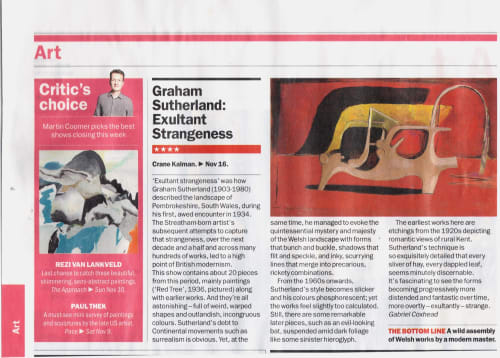'Exultant strangeness' was how Graham Sutherland (1903-1980) described the landscape of Pembrokeshire, south Wales, during his first, awed encounter in 1934. The Streatham-born artist's subsequent attempts to capture that strangeness, over the next decade and a half and across many hundreds of works, led to one of the high points of British modernism.
This show contains about 20 pieces from this period, mainly paintings but also watercolours and studies. And they're all astonishing, full of weird, warped shapes and outlandish, incongruous colours. Sutherland's debt to continental movements such as surrealism is obvious. Yet, at the same time, he managed to evoke the quintessential mystery and majesty of the Welsh landscape, its sense of ramshackle enclosure - with forms that bunch and buckle, shadows that flit and speckle, and inky, scurrying lines that merge into precarious, rickety combinations.
From the 1960s onwards, Sutherland's style becomes slicker and the colours more phosphorescent; yet the works feel slightly too calculated - particularly his fecund, tendrilly compositions, arranged across the canvas like a sort of elaborate stage-set. Scenes incorporating human figures walking through dreamlike worlds - bamboo forests or neoclassical pathways - seem similarly forced. Still, there are some remarkable later pieces, such as an evil-looking bat, suspended upside-down amid dark foliage like some sinister hieroglyph.
Indeed, Sutherland clearly had a flair for this sort of lyrical realism. The earliest works here are his etchings from the 1920s - romantic views of rural Kent - in which his technique is so exquisitely detailed that every sliver of hay, every dappled leaf, seems minutely discernable. It's fascinating to see the forms becoming progressively more distended and fantastic over time, more overtly - exultantly - strange.
All Rights Time Out London

